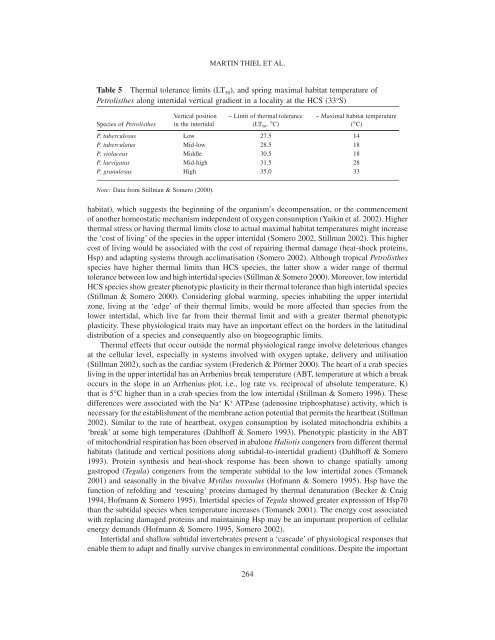the humboldt current system of northern and central chile - figema
the humboldt current system of northern and central chile - figema
the humboldt current system of northern and central chile - figema
Create successful ePaper yourself
Turn your PDF publications into a flip-book with our unique Google optimized e-Paper software.
MARTIN THIEL ET AL.Table 5 Thermal tolerance limits (LT 50 ), <strong>and</strong> spring maximal habitat temperature <strong>of</strong>Petrolis<strong>the</strong>s along intertidal vertical gradient in a locality at <strong>the</strong> HCS (33°S)Species <strong>of</strong> Petrolis<strong>the</strong>sVertical positionin <strong>the</strong> intertidal~ Limit <strong>of</strong> <strong>the</strong>rmal tolerance(LT 50 , °C)~ Maximal habitat temperature(°C)P. tuberculosus Low 27.5 14P. tuberculatus Mid-low 28.5 18P. violaceus Middle 30.5 18P. laevigatus Mid-high 31.5 28P. granulosus High 35.0 33Note: Data from Stillman & Somero (2000).habitat), which suggests <strong>the</strong> beginning <strong>of</strong> <strong>the</strong> organism’s decompensation, or <strong>the</strong> commencement<strong>of</strong> ano<strong>the</strong>r homeostatic mechanism independent <strong>of</strong> oxygen consumption (Yaikin et al. 2002). Higher<strong>the</strong>rmal stress or having <strong>the</strong>rmal limits close to actual maximal habitat temperatures might increase<strong>the</strong> ‘cost <strong>of</strong> living’ <strong>of</strong> <strong>the</strong> species in <strong>the</strong> upper intertidal (Somero 2002, Stillman 2002). This highercost <strong>of</strong> living would be associated with <strong>the</strong> cost <strong>of</strong> repairing <strong>the</strong>rmal damage (heat-shock proteins,Hsp) <strong>and</strong> adapting <strong>system</strong>s through acclimatisation (Somero 2002). Although tropical Petrolis<strong>the</strong>sspecies have higher <strong>the</strong>rmal limits than HCS species, <strong>the</strong> latter show a wider range <strong>of</strong> <strong>the</strong>rmaltolerance between low <strong>and</strong> high intertidal species (Stillman & Somero 2000). Moreover, low intertidalHCS species show greater phenotypic plasticity in <strong>the</strong>ir <strong>the</strong>rmal tolerance than high intertidal species(Stillman & Somero 2000). Considering global warming, species inhabiting <strong>the</strong> upper intertidalzone, living at <strong>the</strong> ‘edge’ <strong>of</strong> <strong>the</strong>ir <strong>the</strong>rmal limits, would be more affected than species from <strong>the</strong>lower intertidal, which live far from <strong>the</strong>ir <strong>the</strong>rmal limit <strong>and</strong> with a greater <strong>the</strong>rmal phenotypicplasticity. These physiological traits may have an important effect on <strong>the</strong> borders in <strong>the</strong> latitudinaldistribution <strong>of</strong> a species <strong>and</strong> consequently also on biogeographic limits.Thermal effects that occur outside <strong>the</strong> normal physiological range involve deleterious changesat <strong>the</strong> cellular level, especially in <strong>system</strong>s involved with oxygen uptake, delivery <strong>and</strong> utilisation(Stillman 2002), such as <strong>the</strong> cardiac <strong>system</strong> (Frederich & Pörtner 2000). The heart <strong>of</strong> a crab speciesliving in <strong>the</strong> upper intertidal has an Arrhenius break temperature (ABT, temperature at which a breakoccurs in <strong>the</strong> slope in an Arrhenius plot, i.e., log rate vs. reciprocal <strong>of</strong> absolute temperature, K)that is 5°C higher than in a crab species from <strong>the</strong> low intertidal (Stillman & Somero 1996). Thesedifferences were associated with <strong>the</strong> Na + K + ATPase (adenosine triphosphatase) activity, which isnecessary for <strong>the</strong> establishment <strong>of</strong> <strong>the</strong> membrane action potential that permits <strong>the</strong> heartbeat (Stillman2002). Similar to <strong>the</strong> rate <strong>of</strong> heartbeat, oxygen consumption by isolated mitochondria exhibits a‘break’ at some high temperatures (Dahlh<strong>of</strong>f & Somero 1993). Phenotypic plasticity in <strong>the</strong> ABT<strong>of</strong> mitochondrial respiration has been observed in abalone Haliotis congeners from different <strong>the</strong>rmalhabitats (latitude <strong>and</strong> vertical positions along subtidal-to-intertidal gradient) (Dahlh<strong>of</strong>f & Somero1993). Protein syn<strong>the</strong>sis <strong>and</strong> heat-shock response has been shown to change spatially amonggastropod (Tegula) congeners from <strong>the</strong> temperate subtidal to <strong>the</strong> low intertidal zones (Tomanek2001) <strong>and</strong> seasonally in <strong>the</strong> bivalve Mytilus trossulus (H<strong>of</strong>mann & Somero 1995). Hsp have <strong>the</strong>function <strong>of</strong> refolding <strong>and</strong> ‘rescuing’ proteins damaged by <strong>the</strong>rmal denaturation (Becker & Craig1994, H<strong>of</strong>mann & Somero 1995). Intertidal species <strong>of</strong> Tegula showed greater expression <strong>of</strong> Hsp70than <strong>the</strong> subtidal species when temperature increases (Tomanek 2001). The energy cost associatedwith replacing damaged proteins <strong>and</strong> maintaining Hsp may be an important proportion <strong>of</strong> cellularenergy dem<strong>and</strong>s (H<strong>of</strong>mann & Somero 1995, Somero 2002).Intertidal <strong>and</strong> shallow subtidal invertebrates present a ‘cascade’ <strong>of</strong> physiological responses thatenable <strong>the</strong>m to adapt <strong>and</strong> finally survive changes in environmental conditions. Despite <strong>the</strong> important264










